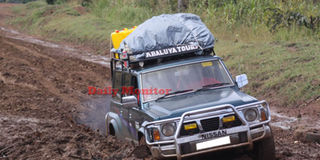Make your slippery road accessible

You can throw broken bricks on the road or dig a trench on the side to prevent mud from forming in the road during the rainy season. PHOTO by Ismail Kezaala
What you need to know:
Some of the dirt roads that lead to our homes can be impassable during the rainy season. However, Pauline Bangirana writes about how you can make such roads passable.
Now that the rainy season has kicked in, some people are faced with a challenge of accessing a given facility or building.
For some, they even find it hard to access their homes on days when it rains.
This is not because the place is far or very remote; some of the difficulties in accessing certain areas are because of the condition of the road.
Forinstance, if it is a dirt road, the mud will make it impossible or potholes that deter easy maneuvering in the dirt roads when it rains.
But how do you make such roads passable regardless of the weather?
Below are some methods one can use to make the road accessible either by foot or vehicle.
Pavers
Vincent Lukyamuzi, a builder, shares that one can buy pavers and place them on the road.
“The pavers make the ground levelled and whether it rains or not, one is not affected by mud or dust during the dry season.”
Sacks of sand or soil
The best way to make a road, especially the uneven road passable, is by placing sacks of soil or sand on the road. You can aim for the parts that have a depression, especially if you drive, as they complicate the swiftness with which a car passes or how a person passes by. Lukyamuzi explains that if mud or overflow of water is what makes a road inaccessible, the sacks of sand or soil will retain the water.
“The sacks hold water and prevent it from over flowing thus reducing the amount of mud, which keeps a road easy to use, especially when it rains.”
Bricks
These can be used in multiple ways. In some instances, you can hire manpower so that they break the bricks. These are usually fillers in the areas that have a depression. Alternatively, they can be placed in the pothole area although this should be done systematically. However, bricks can wear away with time.
Stones
You can settle for the small stones. It is, however, advisable that they be placed carefully so that the sharp ends are not facing up. This can easily cause an injury to someone who moves on foot or damage your tyres. The stones help in leveling the ground although, according to Lukyamuzi, they can be washed away by the rain.
Tarmacking
In relation to the above, some people pour “enkokoto” commonly known as the concrete mix similar to tarmacking the road. This not only levels the road but makes it easier to use in any weather.
Digging
This is another way one can adopt in order to make their road accessible. The inaccessibility may be caused by a bush which can easily be worked upon if the access road is dug and possibly increased. In most cases, the digging can be done as this helps in leveling the ground. Therefore, if the inaccessibility is caused by an unlevelled ground, digging can help create a certain level of uniformity and expansion of the road thus making the road accessible.
However, you should not dig during this season as this will make the road slippery. Alternatively, digging can be done through the use of machines depending on what you can afford.
Trench
Bridget Namirembe shares that her home was inaccessible because when it rained, the rain water would overflow and collect mud at her doorstep. The road was constantly hard to drive in and as a result, she would stay home when it rained. To solve this problem however, she hired the services of some people who dug a trench and created a pathway for the water. This reduced on the mud when it rains and the road is no longer very slippery. So depending on what works for you, transport should not be a problem, especially during the rainy season.




